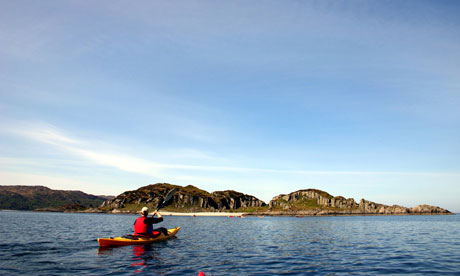FIVE IN BRITAIN
Kayaking in the Hebrides
A
few days' kayaking around stunning Hebridean islands will do more for
your muscles – and your soul – than a couple of weeks on a rowing
machine in a gym ever could. Award-winning adventure specialist
Wilderness Scotland has extended its Scottish Sea Kayak Trail – listed as one of
National Geographic's 50 Tours of a Lifetime in 2011
– to explore the southern section between the sand-fringed isle of
Gigha and Oban. Those worried about aching limbs will be pleased to
learn that a bed, hot shower and excellent pub meal await at the end of
each day on the water. The six-day trip costs £845pp, including
breakfast and packed lunches, all equipment and guide, with four
departures between 26 May and 1 September.
If that doesn't sound challenging enough for you, how about
kayaking around the Sound of Arisaig,
camping on an uninhabited island and living off the fat of the land
(think campfire meals of shore-gathered mussels with seaweed) and a nip
of whisky to ward off the evening chill. Five nights' kayaking and
bushcamping costs £625-£650pp.
Adventure weekend in the Lakes
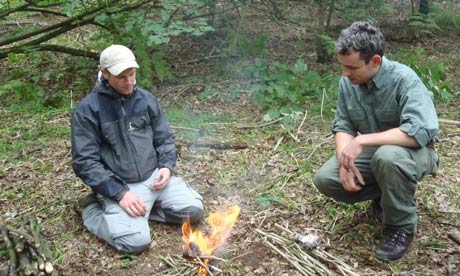
UK-based Field Skills (
fieldskills.com)
specialises in remote and fairly hard-core expeditions in Borneo,
Ladakh and Morocco – but it also runs a number of mini, taster trips on
its doorstep, in the Lakes. On the
Lakes Adventure Weekend
you'll set up an unsupported camp in the woods, spend the night in a
hammock, go for a hefty hike and pick up some new skills along the way
(navigation, preparing a fire lighting, camping). The two-day trip,
running 12-13 May, costs £170pp and includes meals, instruction and
activities.
Careful though – this is the sort of experience where,
warmed by the campfire after an exhilarating day out hill walking, you
find yourself signing up for a two-week jungle survival challenge.
Field Skills is one of a number of small, local activity and adventure specialists listed on
muchbetteradventures.com.
Fitness camp on the Isle of Wight
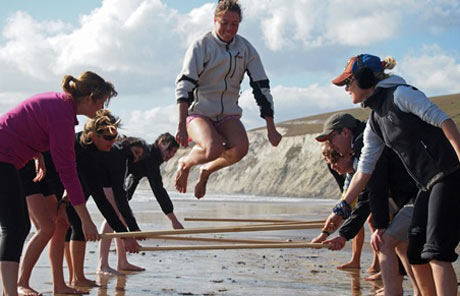
Wild Fitness (
wildfitness.com)
started out running luxury bootcamps in Kenya with a fairly strict
programme of activities – barefoot running, circuits on the beach, sea
swims – aimed at getting results, with experts on hand to offer advice
and motivation. Last year it extended its reach to the rather less
exotic, but more accessible, location of the Isle of Wight where it has
distilled its philosophy into a fitness boosting weekend. The
three-day "energizer course"
involves early morning runs, boxing sessions in the woods, breathing
classes and beach games. It is based at Northcourt, a lovely old manor
house in an area of outstanding natural beauty, where healthy breakfast,
lunch and dinner are served. Trips start in April, and cost from £650pp
for a shared room (a single superior room is £1,085), including all
activities and meals (these early bird prices are valid for bookings
made before 31 January).
Walking around Wales

Now here's a challenge for 2012 – walk round Wales. Come May, you'll
be able to do just that, thanks to a major project that has linked up
several long-distance paths creating a continuous 870-mile route round
the coast of Wales. The official launch of the Welsh Coast Path is
planned for 5 May but many stretches can already be walked, and details
of some of the best walks, both short and long in each of the regions,
can be found at
ccw.gov.uk (a dedicated website will be launched when the path opens).
They include 13.8-mile
Great Orme Circular Trail, which affords fantastic views across the whole north Wales coastline or the six-mile
RSPB Rhossili Coastal Trail in Gower, south Wales, a mix of dramatic cliffs, beach and wild seascape.
Or check out
Ramblers Cymru
for organised guided walks. Another way to stretch your legs and
breathe in some salty sea air is to take part in one of several Welsh
walking festivals, including those in
Gower,
Snowdonia and
Monmouthshire.
Olympic trek across London
 The Olympic Stadium in Stratford, with Canary Wharf beyond. Photograph: Graham Turner for the Guardian
The Olympic Stadium in Stratford, with Canary Wharf beyond. Photograph: Graham Turner for the Guardian
Fancy seeing where this summer's Olympics will take place? Then join
this marathon walk across London. Discover Adventure, has launched a
one-day, 26-mile trek setting off from the Olympic Park
in Stratford (home to the Olympic stadium and village). Going at your
own pace (the walk takes between eight and 12 hours), you'll pass Lords
Cricket Ground (host to the archery events), Hyde Park (triathlon and
marathon swimming) and the Horse Guards Parade Ground (beach volleyball)
before culminating at Greenwich Park and the North Greenwich Arena/the
O2 (equestrian events and the modern pentathlon). Leaders will be on
hand to steer you in the right direction and there will be designated
snack stops. Trips depart 13 May and 1 September 2012 and 31 August
2013. Registration fee is £49pp.
AND FIVE ABROAD
Triathlon camp in France
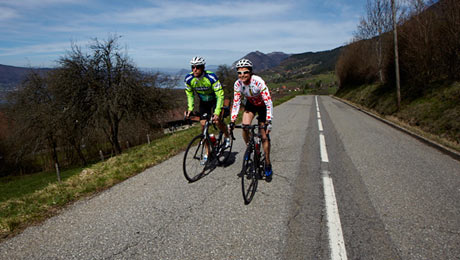
Triathlons have moved beyond the realm of professional athletes and
become increasingly popular among "ordinary" people looking for a
sporting challenge. If you've got your sights set on completing one this
year, but need some guidance, a triathlon camp could be just the
ticket.
Adventure in the Alps offers a week-long retreat hosted by current world champion Christine Hemphill, with one-on-one assessment and video analysis.
Based
at a chalet on the shore of Lake Annecy from 12-18 May, the £1,200pp
price includes all training – incorporating a mini triathlon, six
nights' full board, snacks and water, personal assessment and transfers.
Flights (to Geneva), one dinner, insurance and spa treatments are
extra. The company also offers running camps,
walking holidays, yoga, tai chi and pilates retreats as well as a fitness retreat specifically for over-50s.
Running in New Zealand

I'm going for a run. I may be some time ... Running Wild has launched a
guided trail run across the northern part of New Zealand's South Island.
Covering a daily average of 25km over five to six hours, the eight-day
trip starts with a 26km run along the northern end of the Queen
Charlotte Track, and ends with 35km along the Abel Tasman coastal track –
taking you on breathtaking routes through beech forests, alongside
beautiful lakes, over ridge tops and around high alpine tarns. The trip
departs 25 February and costs NZ$2,850pp (about £1,430) including full
board accommodation, guiding and portage of luggage. Running Wild also
organises customised trips.
Mountain biking in Italy
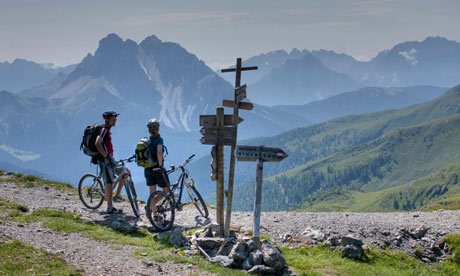 Photograph: Alamy
Photograph: Alamy
Riding through pastures and meadows, past lakes and streams with the
stunning Dolomites as your constant backdrop, you will barely notice
your fitness levels rising on this mountain biking holiday, so
distracted will you be by the idyllic scenery. Over eight days you will
be guided across the Dolomites, over-nighting in mountain
rifugios. Organised by The Healthy Holiday Company (0845 458 0723,
thehealthyholidaycompany.co.uk),
trips are bespoke, with no set departure date, and start from £1,390pp
based on a minimum group of two, including accommodation, meals, bike
hire and guiding for the week. Flights (to Innsbruck) and transfers are
extra. Details of the trip will be on the new website launching next
week.
Swimming in the Caribbean
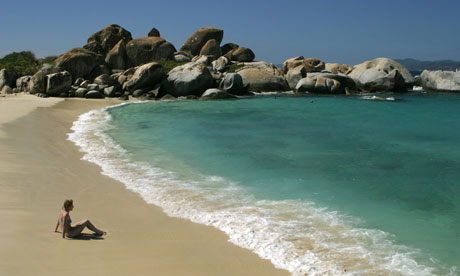 Photograph: Alamy
Photograph: Alamy
Feel pretty confident in the water? How about swimming from Britain
to the US? That's the British Virgin Isles to the US Virgin Isles – but,
still, this
Swimtrek trip around idyllic Caribbean isles and cays
features some of the longest daily swims in the company's portfolio.
Island hopping through pristine waters, swimming over reefs and along
coasts, there's also time out of the water for guided walks and
technique analysis. If you like the idea of this Caribbean holiday,
you'd better get your flippers on – there are just four places left on
the 30 March departure. Based at the
Leverick Bay Resort on Virgin Gorda (pictured above), the trip costs £1,200 including all breakfasts and lunches, but not flights or evening meals.
Walking in Germany
 Burg Rheinstein castle overlooking the Rhine. Photograph: Alamy
Burg Rheinstein castle overlooking the Rhine. Photograph: Alamy
This might stretch the definition of healthy for some, but for anyone
after a gentle trip where you can go at your own pace in your own
company, this is perfect. New from On Foot Holidays is a
self-guided walk along the 65km Rhine Gorge
(graded medium-hard), focusing on the waterway's lesser-known west bank
(the RheinBurgenWeg) as well as on the well-trodden east side.
Walking
between the gorge's 20 castles and fortified, Unesco-sanctified
villages, there are plenty of beer gardens and Riesling vineyards en
route for anyone who likes to keep their spirits up with a glass or two
of the local tipple. Available May–October, the trip costs from £670pp
including eight nights' B&B, one dinner and route information.
Travel extra.











